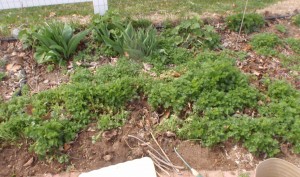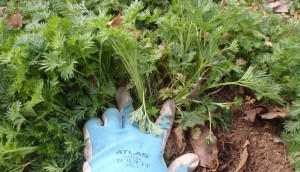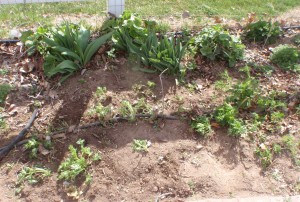
One of the challenges when planting is to choose optimal growing sites for particular plants. Will it get enough sun? Will it have enough moisture? Will the location be too hot for long term survival? Will it be too close to other plants? So, when I have a desirable flower that reseeds, I don’t spend too much energy fighting where it wants to grow.
On the other hand, if it is happy there, there are usually some thinning to be done. The thinning process will be less haphazard and less damaging to the plants if you think about a few things first:
- How tall will the mature plants be? This will affect where you want them to grow. It is good to consider the basic rules of taller plants to the back, if it is a border bed; or toward the middle if the bed will be walked around.
- How close together is best for mature plants? It can be handy to have a basic flower gardening book to look this up, since you may not have the seed packet anymore. I find a reference like the Encyclopedia Of Flower Gardening
to be faster and easier than an internet search for facts like this. This spacing doesn’t have to be exact, but enough growing space will result in better looking plants.
- Is there good weather and nice soil conditions for the plants to survive the disturbance? Any plant will handle the process better if the soil is slightly moist and crumbly, and the weather is on the cool side. The day after a good rain is often a great time for both thinning and weeding.
- Which plants already look the most robust and well developed? They are probably the most likely to both survive the thinning process and will bloom sooner.
- What other plants are growing around them already OR might be trying to grow underneath them? Sometimes it will be fine to let an earlier blooming plant grow over the top of something that is waiting for warmer weather. In fact, if you uncover it when there is still a risk of winter weather, it may suffer or die. But, sometimes, if volunteers are left un-thinned they will smoother other plants, even perennials.

this lily was struggling to grow under the mass of larkspur volunteers - How much do you need to guard or support the plant your are saving, while you thin around it? I often hold the soil down around the plant that will be staying put. It can be best to simply break off the undesirable plants, so that the roots of the chosen plant will not be stressed. Fortunately, most of these plants are usually not as tenacious as weeds when they are still small enough for thinning, so there shouldn’t be trouble with them growing back.
- How much will you need to be weeding as you thin? This is when a tool like the dandelion weeder can be handy, by helping you dislodge the weeds without roughing up the plants that you want to save.
- Will it be helpful to go through and mark the plants you are saving before you begin any thinning? It is easy to loose track of what is being saved and what is being tossed when your nose is close to the ground! More than once, I have saved a plant only to accidentally pull it up when I turn a little and lose track of exactly where I am. A few small sticks from around the yard, or some popsicle sticks can help a lot.
- Will you need some soil handy to add around the plants that are staying put? Often, with the removal of the thicket, the keepers need a little more support at ground level, because the mass of growth was actually doing some of the work that the soil would have been doing. Sometimes there will be enough loose dirt to grab as needed. Sometimes it helps to put some in a bucket.
- Do you want to also transplant some of the volunteers, either for design purposes in the same area, or to try growing them in another part of the garden? Medium sized, but sturdy plants will generally transplant more easily than larger ones. This will mean less shock to the plant and less disturbance to the flower bed soil. It can be helpful to have a few holes dug ahead of time. I have even transplanted things with taproots, like poppies, when they are fairly small. Just make sure to get a chunk of dirt all around the plant and the plant will hardly know you’ve beamed it to another part of the yard!
The area will inevitably look bare after thinning all of that lush green, but it needed to be done. Soon the happy plants will fill it all in again. Meanwhile, I may figure out a time to put some sort of mulch down. It will help both the keepers and the transplants if they get watered soon. If sprinklers or rain will be doing the job within a few hours, this is usually good enough on a cool spring day.
Getting some thinning done helps me think about where I can plant some of the flowers I have taken time to grow in my greenhouse. And it reminds me about things I still want to start from seed. The bulbs that are already blooming dance in the wind for me while I work. Plus, I do enough squats to satisfy any professional trainer. Time spent in the garden has many benefits.


